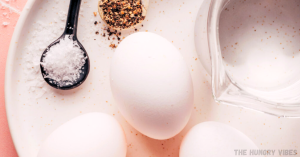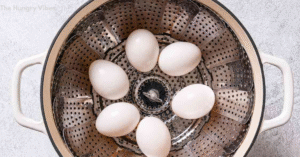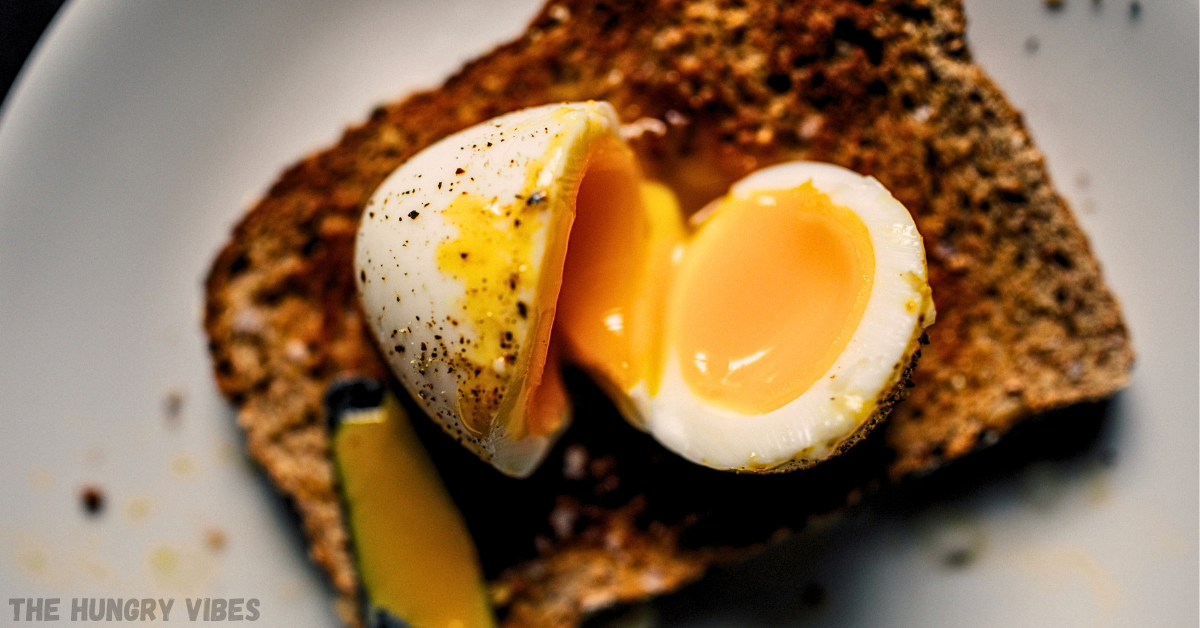Jammy eggs have been enjoyed for centuries with their rich, golden yolks and silky texture. Ancient Romans were among the first to serve soft-boiled eggs as appetizers, while the Japanese perfected ajitsuke tamago, a marinated version commonly found in ramen. Today, jammy eggs are a favorite for their versatility, nutrition, and ease of preparation, making them an essential addition to modern recipes.
Also Read:
Jammy eggs instantly elevate any dish. The best part? They’re simple to make with just a pot of water and the proper technique. This guide will walk you through a foolproof method to achieve perfect jammy consistency.
What Are Jammy Eggs?
Jammy eggs are soft-boiled with slightly set whites and a runny yet thick, jam-like yolk. Unlike fully hard-boiled eggs, jammy eggs have a creamy texture that pairs beautifully with various dishes, from ramen to grain bowls, toast, and even smoked salmon.
The secret to perfect consistency lies in the cooking time and method. Follow this step-by-step guide to master the art of making jammy eggs effortlessly.
Ingredients & Equipment You’ll Need

- Cold eggs (straight from the fridge)
- A pot with a lid
- Ice water (for cooling the eggs)
- A slotted spoon
Step-by-Step Guide to Making Jammy Eggs:
1. Start with Cold Eggs
For the best results, use eggs straight from the refrigerator. This ensures consistent cooking times and the perfect jammy texture.
2. Heat the Water
Fill a pot with about ½ inches of water—just enough to create steam rather than fully submerge the eggs. Unlike traditional boiling methods, steaming helps cook the eggs evenly, preventing cracking.
3. Bring to a Simmer
Place the pot over medium-high heat until the water is simmering. Gentle bubbling is ideal because it doesn’t need to be at a rolling boil.
4. Gently Lower the Eggs

Carefully place the cold eggs into the simmering water using a slotted spoon. This quick temperature contrast helps control cooking time and ensures a soft, jammy yolk.
5. Cover and Cook for 7 Minutes
Once the eggs are in, cover the pot with a lid and let them cook for exactly 7 minutes. This is the magic number for achieving that thick, gooey yolk while ensuring the whites are fully set.
Pro Tip: If you prefer a slightly runnier yolk, you can reduce the cooking time to 6½ minutes.
6. Transfer to an Ice Bath
After 7 minutes, remove the eggs with a slotted spoon and place them into a bowl of ice water. This step stops the cooking process and makes the eggs easier to peel. Let them sit for at least 2 minutes.
7. Peel and Enjoy!
Once cooled, gently tap the eggs on a hard surface and roll them under your palm to loosen the shell. Peel carefully, revealing the beautiful jammy egg inside.
Common Mistakes to Avoid
- Skipping the ice bath – This step is crucial for easy peeling and stopping the cooking process.
- Using room-temperature eggs– Cold eggs help maintain consistency in cooking.
Why Steaming Works Better Than Boiling

You may wonder why steaming is superior to boiling when making jammy eggs. Here’s why:
- More Consistent Cooking: Steaming provides gentler, even heat, preventing overcooking.
- Faster Cooking Time: Since the eggs are only partially submerged, the water heats up quickly, reducing temperature fluctuations.
- Easier Peeling: The hot steam loosens the membrane inside the eggshell, making peeling effortless.
- Prevents Cracking: The gentle heat transition minimizes the risk of shell cracking compared to complete submersion in boiling water.
This method ensures that every jammy egg comes out perfectly without the frustration of stubborn shells or overcooked yolks!
What to Serve with Jammy Eggs?
Jammy eggs pair perfectly with various dishes, adding a rich, creamy texture and protein boost. Serve them with any refreshing meal, or enjoy them alongside smoked Mississippi pot roast for a hearty, flavorful combination. Whether on toast, soups, or with grains like Lebanese rice, jammy eggs elevate every bite.
How to Store Jammy Eggs
- Refrigeration: Store peeled or unpeeled jammy eggs in an airtight container in the refrigerator.
- Use Within 3 Days: Jammy eggs should be eaten within 3 days for the best taste and food safety.
- Keep Unpeeled for Freshness: Leaving the eggs in their shells helps retain moisture and prevents them from absorbing fridge odors.
- Avoid Freezing: Freezing jammy eggs is not recommended, as the yolk texture changes and becomes grainy when thawed.
- Reheating: If you prefer warm, jammy eggs, place them in warm water for a few minutes before serving instead of microwaving, which can overcook the yolk.
Final Thoughts
Jammy eggs are an easy, quick, and delicious way to enhance any meal. With this foolproof method, you’ll never struggle with overcooked or undercooked eggs again. Whether making a simple snack or an elegant brunch dish, these eggs will become your favorite.
Try this technique today and enjoy homemade jammy eggs creamy, golden perfection!
FAQs
- Why is it called a jammy egg?
It’s called a jammy egg because the yolk has a thick, jam-like consistency—soft, creamy, and slightly runny. - How long to boil an egg for jammy?
Boil or steam the egg for 6½ to 7 minutes for the perfect jammy yolk. - What is an 8-minute egg?
An 8-minute egg is a slightly firmer version of a jammy egg, where the yolk is more set but still soft. - What is the difference between a jammy egg and a soft-boiled egg?
A jammy egg has a thicker, custard-like yolk, while a soft-boiled egg typically has a more runny, liquid yolk.

Perfect Jammy Eggs
Method
- Start with Cold Eggs:
- For the best results, use eggs straight from the refrigerator. This ensures consistent cooking times and the perfect jammy texture.
- Fill a pot with about ½ inches of water—just enough to create steam rather than fully submerge the eggs. Unlike traditional boiling methods, steaming helps cook the eggs evenly, preventing cracking.
- Place the pot over medium-high heat until the water is simmering. Gentle bubbling is ideal because it doesn't need to be at a rolling boil.
- Carefully place the cold eggs into the simmering water using a slotted spoon. This quick temperature contrast helps control cooking time and ensures a soft, jammy yolk.
- Once the eggs are in, cover the pot with a lid and let them cook for exactly 7 minutes. This is the magic number for achieving that thick, gooey yolk while ensuring the whites are fully set.
- After 7 minutes, remove the eggs with a slotted spoon and place them into a bowl of ice water. This step stops the cooking process and makes the eggs easier to peel. Let them sit for at least 2 minutes.
- Once cooled, gently tap the eggs on a hard surface and roll them under your palm to loosen the shell. Peel carefully, revealing the beautiful jammy egg inside.
Notes
- Pro Tip: If you prefer a slightly runnier yolk, reduce the cooking time to 6½ minutes.


